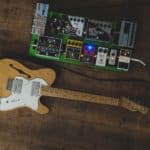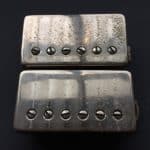Have you come to a moment during your guitar playing where you can’t hear anything but a loud and irritating hum coming from your guitar?
Or you’ve gone to a gig and watched a band play but noticed that the guitarist has a very noisy guitar?
Or when you’ve taken your band to a recording studio preparing for the next new big album, but the hum from your guitar is getting in the way of the mix?
Shielding your guitar is a common method to eliminate these hum issues in order to have hum-free sessions during practice, live, and recording situations.
Although, there are many other methods to reduce the amount of hum you are getting depending on your tones, such as rolling off the gain levels of your amp, switching to humbucker pickups, and adding noise suppression pedals at the start of the signal chain.
However, if all these other methods have been attempted then shielding your guitar can be a useful method to finally eliminate the hum.
So, in short:
Shielding a guitar is a good idea once you exhausted any other way of reducing noise. It is relatively cheap, and many technicians do it. However, it’s not a silver bullet and it only works for reducing interference noise. The hum from single-coil pickups will not be reduced significantly.
What does shielding a guitar mean?
Shielding a guitar is a method of eliminating the hum by adding a “faraday cage” made up of copper tape to the interior section of your guitar.
This includes all the electronic components such as the pick-ups, volume pots, wiring, etc.
With the electronic components exposed to other electrical equipment nearby, it becomes inevitable that the guitar is vulnerable to feedback from said nearby electrical equipment.
To tackle this, the faraday cage can block those frequencies coming from other electronics which leaves the guitar shielded and therefore, blocks those electric signals coming from other equipment.
Do guitars come factory shielded?
It is safe to assume that most high-end guitars come factory shielded but not beginner-level guitars which may be a big part of why expensive guitars seem more convenient to block feedback in practical environments full of electronic equipment.
The common consensus is that if the guitar holds a ground wire and grounding lug in the body as I do in my Fender American Professional Stratocaster, it is shielded.
It is also known that Fender paints over their shielding paint with body color so, at first glance, the shielding component of the interior may not be noticeable at first glance.
Is shielding necessary?
There is no negative impact in having the guitar shielded. It may not necessarily be a priority to install the shielding but it is worth the investment to avoid the risk of leaving your guitar exposed to hum.
In my own experience, I have owned non-shielded guitars and shielded guitars.
There is a noticeable difference between the two especially in different environments whether it’s practicing in my bedroom or on stage.
Especially during recording situations, it is important to explore any opportunity to eliminate unwanted noise.
How effective is shielding to prevent hum?
Shielding can be very effective by protecting the guitar from incoming frequencies but that doesn’t necessarily mean it will stop the hum that is caused by the guitar itself.
For example, a shielded guitar with humbuckers can be completely hum-less due to the pickup’s nature of canceling hums.
However, a shielded single-coil guitar can receive the same effectiveness from the same shielding as the humbuckers but it will still carry some hum due to the single-coils naturally being noisy pickups.
Does shielding help prevent interferences?
The main function of the copper tape shielding the interior of the guitar is to prevent interference from nearby electronic devices.
It goes a long way to have the shielding installed into the guitar as the instrument is often involved in environments filled with other devices such as phones, laptops, amplifiers, microphones, speakers, etc.
These interferences can be blocked off simply by adding the copper tape to the interior body and thereby shielding the guitar, preventing further interferences.
How much does shielding a guitar cost?
The cost of materials and installation of shielding a guitar can cost anywhere between $30 and $50 depending on the type of materials used and who is performing the installation.
Can you shield your guitar on your own?
Yes. Anyone is capable of performing the installation to shield the guitar’s electronics.
It can also be cheaper to DYI and acquire the necessary materials for the installation yourself.
Here is a link to a YouTube tutorial showing you how to shield your guitar’s electronics.
Do all guitar techs perform this mod?
Not every guitar technician performs this type of modification but it will be relatively easy to find a professional who offers this service.
I would advise asking around local guitar shops as they always have a technician available.
Otherwise, use social media to ask around for private guitar technicians who may be available for a local meet-up.
Is shielding a guitar really worth it?
Shielding guitar is worth it if you are using your guitar in professional working environments such as teaching, working in recording studios, or performing regularly as a gigging musician.
As a working guitarist, you will always be surrounded by electronic devices that could interfere with your guitar and create unwanted noise.
Tackling these possible interferences is well-advised in order for your guitar to be reliable in a professional working environment.
However, if you rarely take your guitar outside your practicing room, shielding may not be a top priority.
But if hum is a concern for you, either way, shielding your guitar is worth the investment.

Hello there, my name is Ramiro and I’ve been playing guitar for almost 20 years. I’m obsessed with everything gear-related and I thought it might be worth sharing it. From guitars, pedals, amps, and synths to studio gear and production tips, I hope you find what I post here useful, and I’ll try my best to keep it entertaining also.





